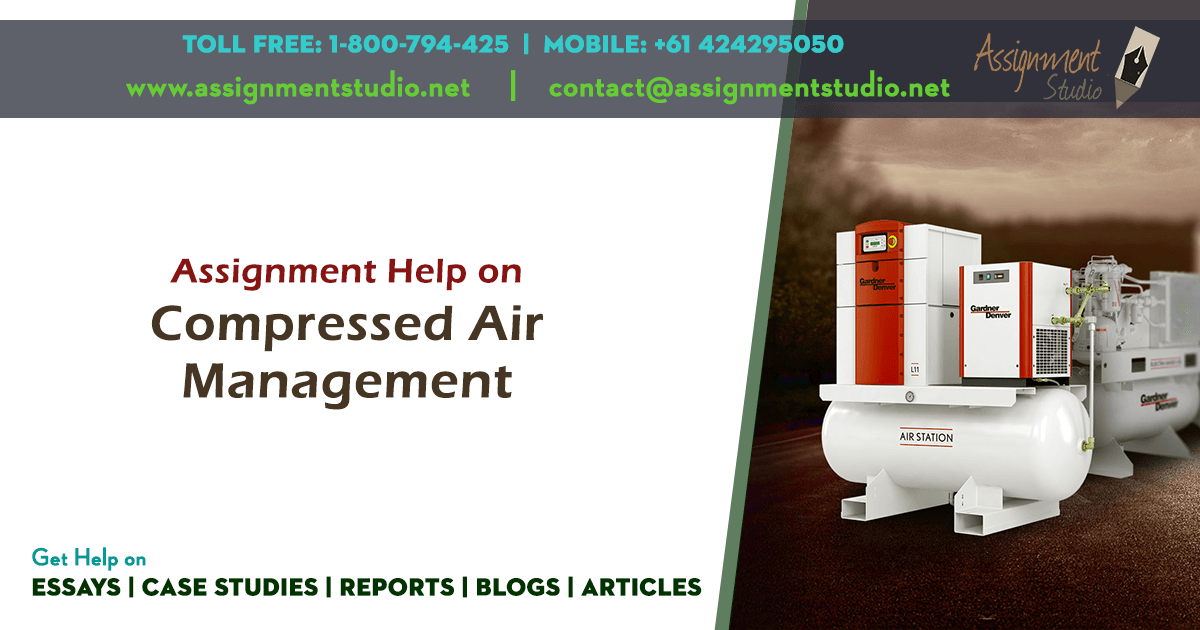Compressed Air Management | Assignment Help
Compressed Air Management
Description of the problem
Most modern manufacturing plants in the world use compressed air. They use it to run various pneumatic tool, doors, actuators, valves etc. Utilization of this important commodity efficiently is ideal for energy savings. Most of the time the companies don’t even know that it is being wasted as it cannot be seen and sometimes not even heard. Hence the annual operating costs keep getting higher overtime. There are many key issues central to efficient compressed air management such as systematic detection of leaks, reliability of the equipment used, cost of the equipment, time utilization, maintenance etc. The purpose of this research is to try and identify a step-by-step procedure to efficiently detect and fix leaks in the air distribution system thereby increasing their efficiency. It is also equally important to try and create a sound periodic maintenance process so that leaks can be checked systematically. The procedure will take into account the variety of leaks and what priority to give them in solving them. This report endeavors to meet most of these issues in a cost effective and time saving manner. These processes will try enabling companies to reduce annual operating costs significantly. The results can also have a pleasing environmental effect as it saves energy and reduces pollutants.

Background
In order to understand and improve existing methods we have to look at what are the methods being used. The trend usually is to change the air compressor to a newer or more efficient one. For example, sometimes the compressor is too big for the existing facilities as noted by the case study done on an industrial manufacturer (Outperformer 2012, Case-study). But most companies though only detect leaks and fix them, which has limited savings on the long run. This is usually used when the cost to replace the compressor is very high. But to have long-term results, there is a need to look at the compressed air system as a whole. It is important to look at it as a system as supported by Shafer (1997). This takes into consideration all the components related to compressed air such as air demand, leak reduction, air quality, pressure, maintenance etc. This type of strong compressed air management system can help the company save a lot of money on annual operating costs, which can be put to better use elsewhere in the company. The research will try to find a step-by-step way to reduce operating cost due to leakage, lack of maintenance and various other factors. It will look at areas in which leaks occur the most with the objective of finding out why they leak the most in those places. Maintenance schedules may be followed so that the maintenance can be of a predictive and hence preventive nature. The system will be looked at as a whole and also as individual components as well to get a more comprehensive result
The companies that use this type of process will be the key beneficiaries. The economic benefits alone will interest the company significantly as they always are in search of new cost reducing ideas. Companies who want to promote their environmental friendliness can also make use of the procedure as this greatly reduces pollution due to waste energy saved. It may also result in reduction of health issues related to hearing due to excess white noise produced in leaks when earplugs are not used. Since this procedure has to be carried once every few years or so, it gives companies time to think about it as well. However, Shafer (1997) also says that maintenance needs to be conducted periodically. This may require the creation of team of people whose jobs are to detect and rectify leaks. The help of employees who work in the plant can also be used to inform these teams when they come across a leak.

Research objectives
The success of the research depends on the completion of the objectives. The objectives of this research are to
-
Try and find an efficient step-by-step procedure to be followed to ensure that compressed air is not wasted.
-
Find out the different factors to be taken in to consideration for this procedure.
-
Identify problem areas where frequent and repetitive leaks occur.
-
Find a systematic method of periodic maintenance.
-
Try and find potential cost effective tools and equipment needed to carry it out.
-
Calculate the expenditure to a company in setting up this process.
-
Identify the economic benefits of the process in energy savings and operating costs.
-
Try and identify the environmental benefits of the process.
Scope of the research
The scope of this research will limit itself to manufacturing plants. It will tackle key issues related to the working of the system but will not involve itself in the installation of new facilities. Although the research can be applied to any work environment that uses compressed air, it will primary concentrate on manufacturing facilities with the scope for expansion into other fields if sufficient data cannot be collected as evidence. The maintenance procedures for example can be implemented easily to other plants. The research will concentrate on how to detect and resolve leaks in air tools and pipes during production and non-production hours in a systematic manner. Different types of working schedules will also be examined to find out which might be using more compressed air as studied by Shafer (1997). Issues related to malfunctioning compressors will not be taken up, as replacement would be the best option. The research will also only take into consideration benefits related to environment and not health that may happen by the implementation of the procedure. The environment in which the plant works under will also be considered to not be dynamic in nature. The leaks that occur inside enclosed structures or leaks that are out of reach will not to taken into consideration.
Key variables to be addressed
Research always has variables that can be measured and manipulated. The pressure of the compressed air is one such variable, which greatly affects the effectiveness of the system, as lower or greater pressure is undesirable. The quality of air is another variable that leads to wear and tear and creation of leaks. The amount of time the compressor works in a day is another, which can be used to improve the efficiency of the system. The compressor air demand is another key variable. For example if the compressor produces more than what is required, the excess capacity is wasted. The size of the leaks is also important as it leads the way to priorities which leaks have to be fixed first (Van Tonder 2011). They also produce different amounts of white noise, which will be the primary way to detect leaks in this research. They will be detected using ultrasonic detectors, which can sense this white noise. Gauges or tools usually measure most of these variables. Some may have to be calculated such as air quality and air demand.
Source data
Data collection is a very important part of any research. For this research, an attempt will be made to collect data from the source i.e. from a company that is facing problems related to compressed air. Data related to leaks may be collected using an ultrasonic detector, which can sense white noise emitted during leaks (Van Tonder 2011). The leaks that are out of reach may be excluded for the purposes of the research. Data will further be collected from secondary sources such as other companies, which have already conducted studies on compressed air systems of different types of manufacturing plants. The research will also base itself on data collected and some on data calculated from the measured variables. However some data related to the plan of the plant may also be required to find an efficient route to be taken during periodic maintenance. Air audit reports may also be examined to get a clearer view of the problem at hand (Shafer 1997). Some of the data will just act as guide to the research while others will be analyzed. This may include the use of graphs, tables or calculations. The graphs may help us get a visual interpretation of the problem at hand. The tables could be used to list out variables collected.



